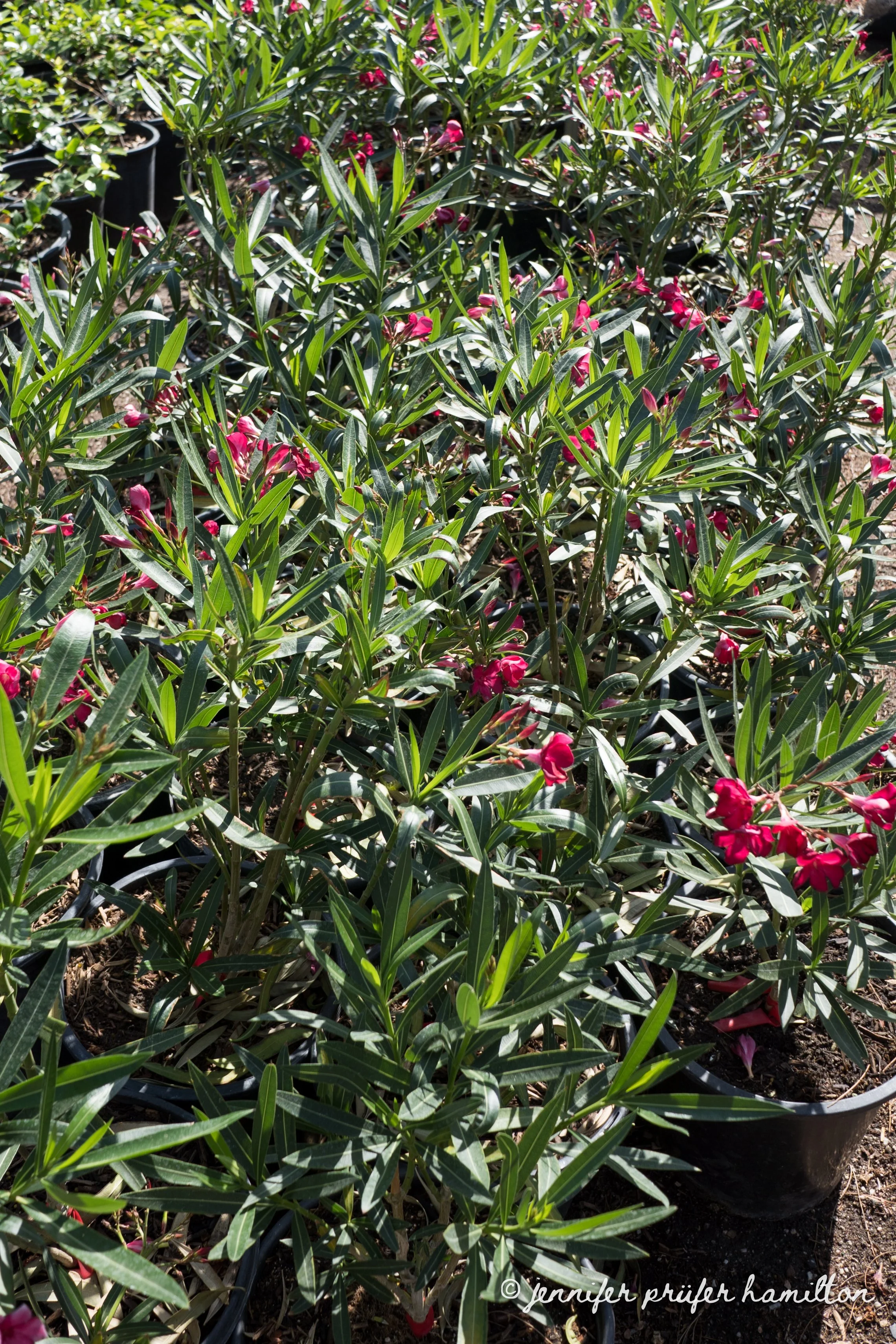Oleander
Oleander is a popular sight in the Southwest due to its reliable blooms even in the intense desert sun.
It tends to be a polarizing plant among gardeners. Its biggest fans praise it for its astonishing heat and drought tolerance, while its biggest critics disapprove it due to its strong toxicity and tendency to reseed.
Botanical name: Nerium oleander
Other names: Rose bay, rose laurel
Oleander for sale at the nursery
TABLE OF CONTENTS
Oleander Appearance
Oleander is a large, woody, flowering shrub that grows to 10-20 feet tall and wide, depending on the variety. Some dwarf varieties grow to only 4 feet tall.
Multi-stemmed with dense branches and leaves.
Evergreen leaves are narrow and long and taper at the end. They are thick and deep green, growing in whorls of 3-4.
Long blooming season from spring to fall in the Coachella Valley. Popular varieties of flowers are white, yellow, peach, pink, and red. The flowers are showy and grow in clusters. Some are fragrant and some are not.
Small fruit pods with seeds.
Oleander Landscaping Tips
Grows quickly. Great candidate for establishing a hedge.
Can also be pruned into a small standalone tree.
Popular in deserts across the Southwest due to its strong heat and drought tolerance.
Also popular alongside highways due to its wind, pollution, and poor soil tolerance.
Extremely toxic. Can be fatal for humans, pets, and livestock if any part of the plant is ingested. Can also cause contact dermatitis. Wear gloves and handle with care. Be aware of sap. Do not burn any parts of the plant.
Frost-sensitive. In late winter, cut back any frost damage.
Tolerates heavy pruning well.
Oleander in 5 gallon containers
Oleander Origin
Oleander is widely naturalized across the world. Its exact origins are unknown.
Oleander Care
Soil: Fast draining soil is key. Can tolerate different soil types.
Temperature: Prefers warm weather. Can withstand temperatures down to 28 degrees for a brief period of time.
Water: Drought tolerant. We recommend occasional, deep waterings. Allow the soil to be dry between waterings. Either use a moisture meter or stick your finger through the soil to gauge the moisture level.
Sun: Full sun. Partial shade is ok in Palm Springs region.
Oleander Problems
Pests: Oleanders have minimal pests, which are usually aphids and spider mites.
For aphids, blast them off with water if the infestation is light. Otherwise, use horticultural oil or soapy water.
For spider mites, control the infestation as soon as it’s discovered. Some options are horticultural oil applied several days apart as well as insecticidal soap combined with hydrogen peroxide. Use commercial pesticide for severe infestations.
Whenever using any kind of pesticide, be aware that it can damage the plant if the temperatures are in the 80s or above.
Signs of overwatering: Fewer flowers, root rot
Signs of too little water: Wilting, dropping leaves
Signs of too much sun: Fading color
Signs of too little sun: Etiolation, dulling color of flowers
Oleander Propagation
Take 1 foot cuttings from the tip and plant in soil.
FAQ
How much does Oleander cost?
At our nursery, oleander costs $25 for a 5-gallon container, $75 for a 15-gallon container, and $125 for a 24” box.
Prices are subject to change. Please contact us for the most up-to-date information on pricing. We may have larger sizes available. We provide installation services locally at a separate cost.
Are oleanders poisonous to the touch?
Yes, it can cause contact dermatitis. Wear gloves and handle with care. Be aware of sap.
How fast does oleander grow?
Oleanders are vigorous plants. In the Palm Springs region, they usually grow about 2-3 feet a year.
Summary
| SIZE (H X W) | 10-20 feet |
|---|---|
| FLOWER COLOR | White, pink, red |
| FLOWER SEASON | Spring to Fall |
| EXPOSURE | Full Sun |
| WATER | Low |
| GROWTH RATE | Moderate |
| HARDINESS | 28º F, USDA Zone 8 |
| PRUNING | As Needed |

